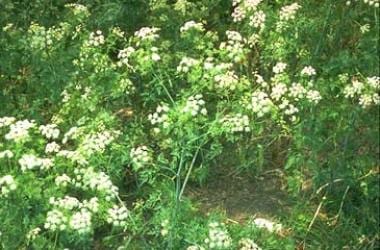Practice Essentials
Plants have evolved highly complex systems of defense against most of their natural enemies (eg, insects, animals). At the very least, these defenses make many plants unpalatable; however, some can be fatal to the inexperienced forager. [1] Resins represent one form of plant defense. See the image below.
Throughout human history, plants have played pivotal roles as medicines and poisons. Our medical predecessors may not have known the exact mechanisms involved, but they did recognize various plants as instrumental for medical treatment and as instruments of murder. With current technology, we finally are able to peer into plants and see their vast arsenal of chemicals, including glycosides, alkaloids, oxalates, and resins.
A rapid toxidromic classification of plant poisonings has been developed for use by first responders and other urgent-healthcare providers to assist in rapid identification of poisonous plant–induced toxidromes and to reduce confusion among highly toxic, less toxic, and nontoxic plants. The resultant 4 specific toxidromes of plant poisonings identified in the scientific literature are stratified as cardiotoxic, neurotoxic, cytotoxic, and gastrointestinal/hepatotoxic poisonings, all of which have caused fatalities worldwide after both intentional and unintentional ingestions. [2]
Fatalities after inhalation of urushiol from the smoke of burning poison ivy have been reported. [3]
When considering poisoning by plant resin, always be aware of possible co-intoxicants, which may blur the clinical picture. Such co-intoxicants include pharmaceutical and illicit drugs, herbicides, fungicides, insecticides, fertilizers, and artificial plant hormones.
Examples of unintentional toxic plant ingestion include the following:
-
Hikers who mistake poisonous plants for nutritious ones
-
Herbalists who seek natural remedies or natural highs and end up with poisonous concoctions
-
Children who are attracted to brightly colored fruits and leaves of poisonous plants (this group accounts for the most calls to poison centers regarding plant toxicity)
See 11 Common Plants That Can Cause Dangerous Poisonings, a Critical Images slideshow, to help identify plant reactions and poisonings. For patient education information, see the First Aid and Injuries Center, as well as Poisoning and Activated Charcoal.
Pathophysiology
Resins are a diverse group of chemical compounds that share chemical characteristics, such as insolubility in water, solidity at room temperature, and lack of a nitrogen group. Resin compounds formed with sugars are called glycoresins; those formed with oils are called oleoresins. Latex is a term used to describe these toxins when found in emulsions (ie, urushiols, which are catechol derivatives) [4] in ducts of plants. They are released and activated when structural damage to the plant occurs.
Epidemiology
While some individuals ingest toxic plants to attempt suicide, most present to the emergency department after unintentional toxic plant ingestion.
The 2021 Annual Report of the American Association of Poison Control Centers' National Poison Data System (NPDS) documented 53,951 plant exposures. The 25 most commonly involved plant species and categories account for 41.6% of all reported plant exposures. Seven of the top 25 categories are for unknown plants and comprise 10% of exposures. This reflects the difficulty in identification. See the following [5] :
-
Phytolacca americana (L) – 3597 exposures
-
Cherry (not otherwise specified) – 3454
-
Unknown botanical name (unknown toxic types or unknown if toxic) – 2021
-
Berry (not otherwise specified) – 1440
-
Plants, general unknown – 1071
-
Elephant's ear – 947
-
Poison ivy – 807
-
Ilex spp (not otherwise specified) – 769
-
Plants-solanine – 710
-
Spathiphyllum spp – 674
-
Apple (fruit & seed) – 615
-
Plants-cyanogenic glycosides – 600
-
Unknown botanical name (amygdalin and/or cyanogenic glycosides) – 598
-
Unknown botanical name (non-toxic) – 575
-
Epipremnum areum – 544
-
Plants-oxalates – 451
-
Unknown botanical name (oxalates) – 432
-
Nerium oleander – 425
-
Euphorbia tirucalli – 416
-
Plum (species unspecified) – 403
-
Conium maculatum – 403
-
Unknown botanical name (skin irritants excluding oxalate-containing plants) – 394
-
Unknown botanical name (gastrointestinal irritants excluding oxalate-containing plants) – 381
-
Unknown botanical name (other toxic types) – 376
-
Plants-cardiac glycosides – 358
Nearly 60% of plant exposures reported to US poison centers in 2021 involved children younger than 6 years. [5]
-
Hemlock. Photo by Cornell University Poisonous Plants Informational Database.
-
Daphne. Photo by Cornell University Poisonous Plants Informational Database.
-
Poison ivy. Photo by Cornell University Poisonous Plants Informational Database.
-
Poison ivy. Photo from the Centers for Disease Control and Prevention.
-
Poison oak. Photo by Cornell University Poisonous Plants Informational Database.
-
Poison sumac. Photo by Cornell University Poisonous Plants Informational Database.
-
Poison ivy rash. This photograph shows an individual's arm with a blistering poison ivy rash. Hardin Library for the Health Sciences, University of Iowa Public Domain Picture (http://www.lib.uiowa.edu/haRDIN/MD/cdc/4483.html) and Centers for Disease Control and Prevention.
-
Poison oak rash. This photograph depicts an individual's arm with a blistering poison oak rash. Note the linear pattern to the lesions. Hardin Library for the Health Sciences, University of Iowa Public Domain Picture (http://www.lib.uiowa.edu/haRDIN/MD/cdc/4484.html) and Centers for Disease Control and Prevention.










